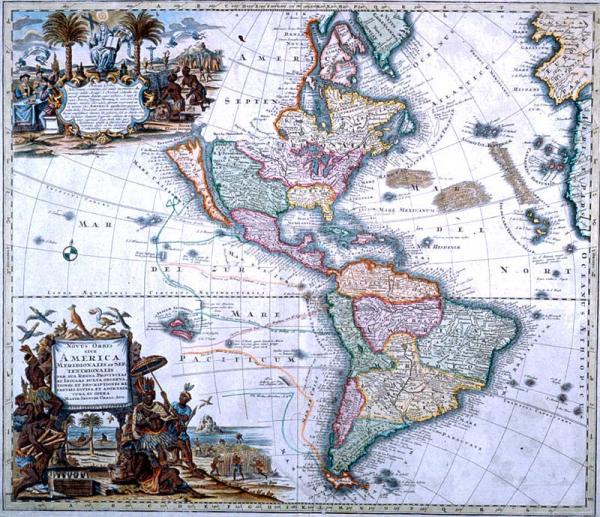Novus Orbis sive America Meridionalis et Septentrionalis [The New World, or South and North America]

North and South America, routes of explorers in the Pacific; California as an island; New Orleans not delineated.
Seutter, Matteus
Augsberg
Beautiful coloring. 9/13/00: for more on the serra, see http://www.lib.rochester.edu/camelot/teams/amnts.htm. See Phillips, Vol. 1, p. 329, #583. See also "California as an Island," in "Map collectors' Cdircle, Vol. 1, 1964.
Plate 8 From "Atlas Novus."
Religion was a compelling motivation for European imperialism, and the opportunity to convert "heathen" Indians provided both justification and means to conquer the indigenous peoples of the New World. Two Indians kneel reverently before the Virgin Mary, flanked on the right by an altar prepared for Holy Communion and on the left by Europeans at a dining table. The lower cartouche portrays tranquil Indians surrounded by standard symbols representing the Americas. The seated figure wears a feathered headdress, armband, and skirt. A servant shades him from the sun with a baldachin (parasol), while others in the background and to the left are what appears to be sugar cane and tobacco. The baldachin symbolized status, rank, or nobility, and was often included in European depictions of America's indigenous peoples. In the center background someone rests in a hammock suspended between two palm trees while another sails quietly out to sea. A pelican, cockatiel, and whimsical flying fish, some sporting saw-like beaks, hover above the title. The latter sea creatures are probably the artist's conception of the serra, which, according to bestiary lore, were winged sea monsters. The placement of the two scenes illustrating this work is significant. By depicting numerous symbols associated with Roman Catholicism such as the Madonna holding a cross, a chalice, and the scriptures in a cartouche seen above that of one showing Indians, a subtle message is conveyed: European contact with Indians would yield vast spiritual riches in the form of Christian converts and benefit the indigenous people, who, because they did not practice a Christian faith, were "beneath" those who did.